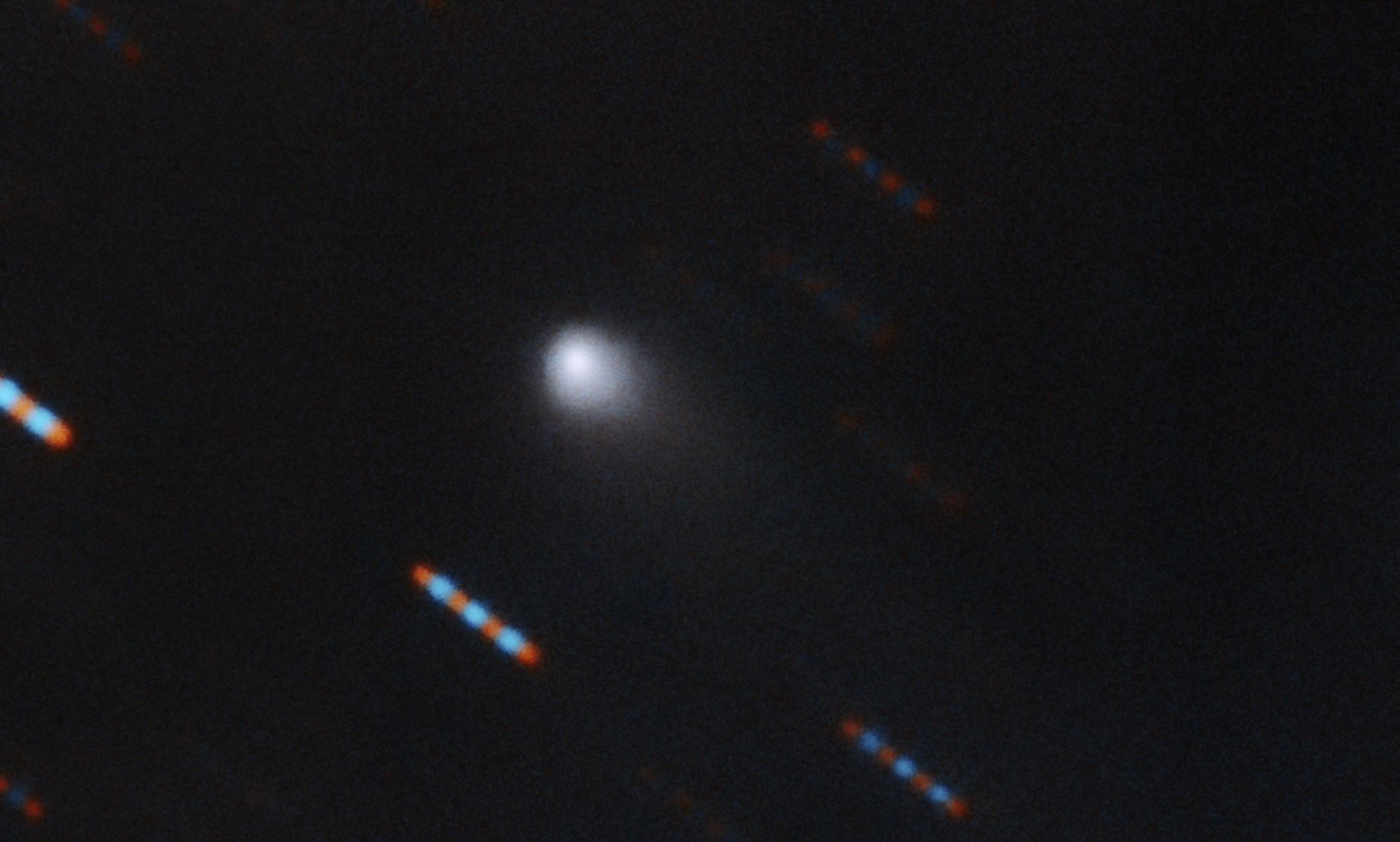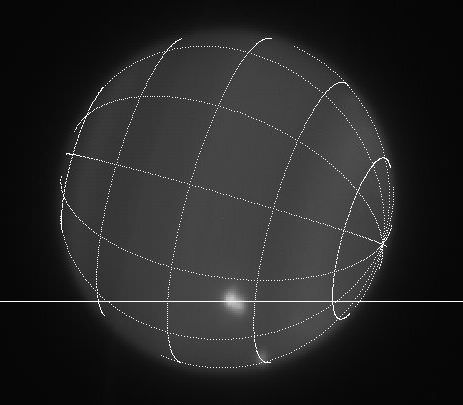On August 30th, amateur astronomer Gennady Borisov spotted a comet of extrasolar origin passing through our Solar System. This is the second time in as many years that an interstellar object has been observed (the last being ‘Oumuamua 2.0 in 2017). Thanks to the Gemini Observatory, we now have pictures of this comet, making it the first object of its kind to be successfully imaged in multiple colors!
Continue reading “Images are Starting to Come in of the New Interstellar Comet”Super-sensitive Camera Captures a Direct Image of an Exoplanet
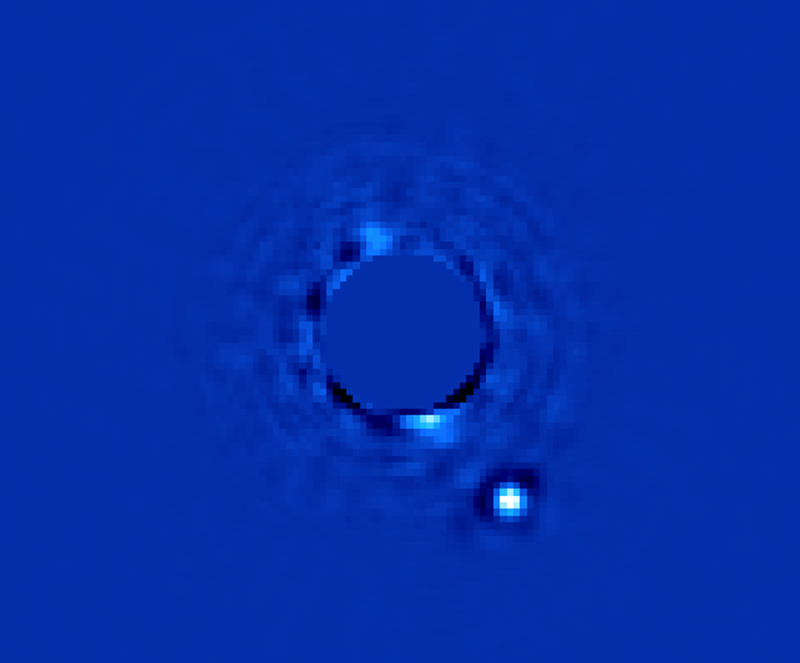
The world’s newest and most powerful exoplanet imaging instrument, the recently-installed Gemini Planet Imager (GPI) on the 8-meter Gemini South telescope, has captured its first-light infrared image of an exoplanet: Beta Pictoris b, which orbits the star Beta Pictoris, the second-brightest star in the southern constellation Pictor. The planet is pretty obvious in the image above as a bright clump of pixels just to the lower right of the star in the middle (which is physically covered by a small opaque disk to block glare.) But that cluster of pixels is really a distant planet 63 light-years away and several times more massive — as well as 60% larger — than Jupiter!
And this is only the beginning.
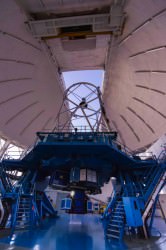
While many exoplanets have been discovered and confirmed over the past couple of decades using various techniques, very few have actually been directly imaged. It’s extremely difficult to resolve the faint glow of a planet’s reflected light from within the brilliant glare of its star — but GPI was designed to do just that.
“Most planets that we know about to date are only known because of indirect methods that tell us a planet is there, a bit about its orbit and mass, but not much else,” said Bruce Macintosh of the Lawrence Livermore National Laboratory, who led the team that built the instrument. “With GPI we directly image planets around stars – it’s a bit like being able to dissect the system and really dive into the planet’s atmospheric makeup and characteristics.”
And GPI doesn’t just image distant Jupiter-sized exoplanets; it images them quickly.
“Even these early first-light images are almost a factor of ten better than the previous generation of instruments,” said Macintosh. ” In one minute, we were seeing planets that used to take us an hour to detect.”
Despite its large size, Beta Pictoris b is a very young planet — estimated to be less than 10 million years old (the star itself is only about 12 million.) Its presence is a testament to the ability of large planets to form rapidly and soon around newly-formed stars.
Read more: Exoplanet Confirms Gas Giants Can Form Quickly
“Seeing a planet close to a star after just one minute, was a thrill, and we saw this on only the first week after the instrument was put on the telescope!” added Fredrik Rantakyro a Gemini staff scientist working on the instrument. “Imagine what it will be able to do once we tweak and completely tune its performance.”
Another of GPI’s first-light images captured light scattered by a ring of dust that surrounds the young star HR4796A , about 237 light-years away:
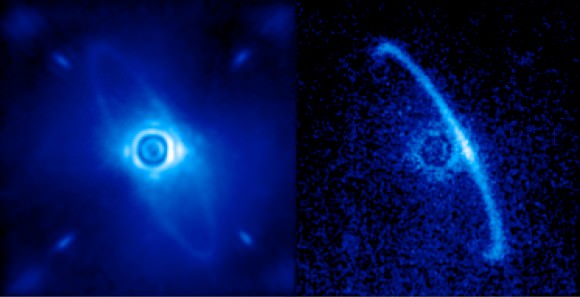
The left image shows shows normal light, including both the dust ring and the residual light from the central star scattered by turbulence in Earth’s atmosphere. The right image shows only polarized light. Leftover starlight is unpolarized and hence removed. The light from the back edge of the disk (to the right of the star) is strongly polarized as it reflects towards Earth, and thus it appears brighter than the forward-facing edge.
It’s thought that the reflective ring could be from a belt of asteroids or comets orbiting HR4796A, and possibly shaped (or “shepherded,” like the rings of Saturn) by as-yet unseen planets. GPI’s advanced capabilities allowed for the full circumference of the ring to be imaged.

GPI’s success in imaging previously-known systems like Beta Pictoris and HR4796A can only indicate many more exciting exoplanet discoveries to come.
“The entire exoplanet community is excited for GPI to usher in a whole new era of planet finding,” says physicist and exoplanet expert Sara Seager of the Massachusetts Institute of Technology. “Each exoplanet detection technique has its heyday. First it was the radial velocity technique (ground-based planet searches that started the whole field). Second it was the transit technique (namely Kepler). Now, it is the ‘direct imaging’ planet-finding technique’s turn to make waves.”
This year the GPI team will begin a large-scale survey, looking at 600 young stars to see what giant planets may be orbiting them.
“Some day, there will be an instrument that will look a lot like GPI, on a telescope in space. And the images and spectra that will come out of that instrument will show a little blue dot that is another Earth.”
– Bruce Macintosh, GPI team leader
The observations above were conducted last November during an “extremely trouble-free debut.” The Gemini South telescope is located near the summit of Cerro Pachon in central Chile, at an altitude of 2,722 meters.
Source: Gemini Observatory press release
‘The New Cool’: How These Sharp Space Pictures Were Snapped From A Ground Telescope

Rise above Earth with a telescope, and one huge obstacle to astronomy is removed: the atmosphere. We love breathing that oxygen-nitrogen mix, but it’s sure not fun to peer through it. Ground-based telescopes have to deal with air turbulence and other side effects of the air we need to breathe.
Enter adaptive optics — laser-based systems that can track the distortions in the air and tell computers in powerful telescopes how to flex their mirrors. That sparkling picture above came due to a new system at the Gemini South telescope in Chile.
It’s one of only a handful pictures released, but astronomers are already rolling out the superlatives.
“GeMS sets the new cool in adaptive optics,” stated Tim Davidge, an astronomer at Canada’s Dominion Astrophysical Observatory.
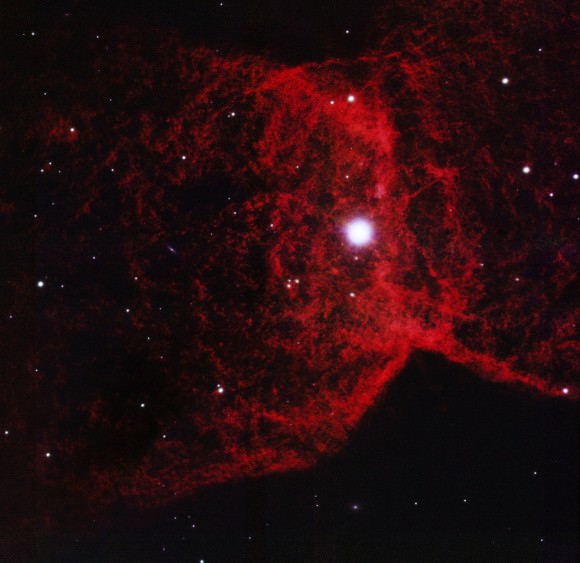
“It opens up all sorts of exciting science possibilities for Gemini, while also demonstrating technology that is essential for the next generation of ground-based mega-telescopes. With GeMS we are entering a radically new, and awesome, era for ground-based optical astronomy.”
Other telescopes have adaptive optics, but the Gemini Multi-Conjugate Adaptive Optics System (GEMS) has some changes to what’s already used.
It uses a technique called “multi-conjugate adaptive optics”. This increases the possible size of sky swaths the telescope can image, while also giving a sharp view across the entire field. According to the observatory, the new system makes Gemini’s eight-meter mirror 10 to 20 times more efficient.
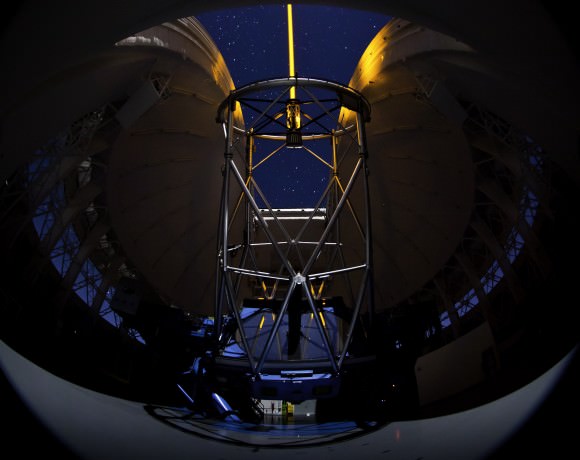
The system uses a constellation of five laser guide stars, and has several mirrors that can deform according to measurements obtained by the sodium laser. We have more technical details in this past Universe Today story by Tammy Plotner.
The next step will be seeing what kind of science Gemini can produce from the ground with this laser system. Some possible directions include supernova research, star populations in galaxies outside of the Milky Way, and studying more detail in planetary nebulae — the remnants of low- and medium-mass star.
Check out more photos from Gemini at this link.
Source: Gemini Observatory
New Images of Comet ISON Hurtling Towards the Sun
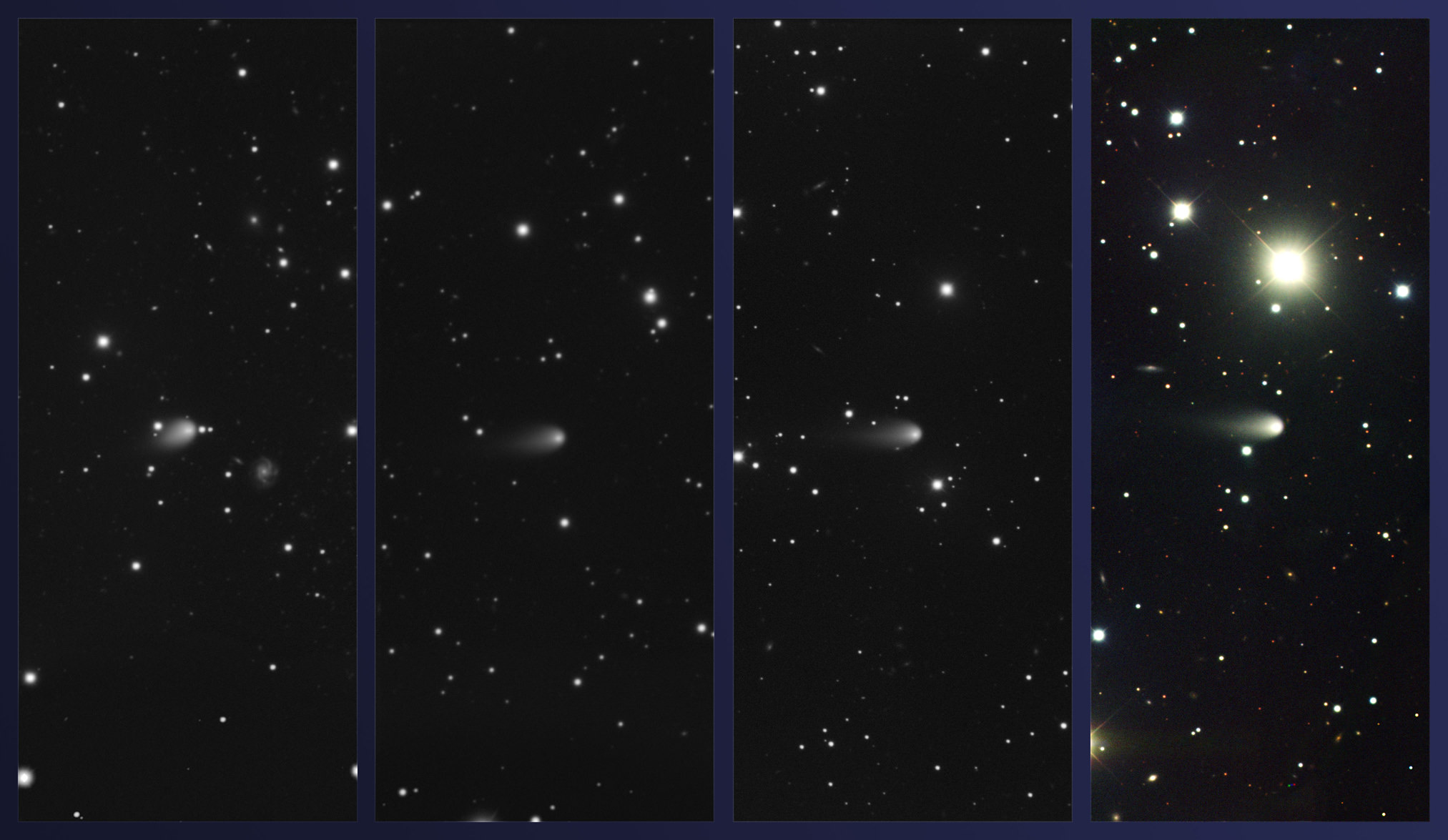
As Comet C/2012 S1 (ISON) heads closer to Earth, we’re getting a better view of what has been billed by some as the “Comet of the Century.” Astronomers say these new photos from the Gemini North telescope on Mauna Kea, Hawai‘i provide hints of how well this comet might survive one of the closest comet encounters with the Sun ever recorded, on November 28, 2013.
With astronomy enthusiasts hopeful and optimistic about having a spectacular comet visible in our skies, it’s anyone’s guess if the comet will actually survive its extremely close pass of the Sun to become early morning eye-candy in early December 2013.
The time-sequence images, spanning early February through May 2013, show that the comet is quite active, despite how distant it is from the Sun.
When Gemini obtained these images, the comet ranged between roughly 455-360 million miles (730-580 million kilometers; or 4.9-3.9 astronomical units) from the Sun, or just inside the orbital distance of Jupiter. Each image in the series, taken with the Gemini Multi-Object Spectrograph at the Gemini North telescope on Mauna Kea, Hawai‘i, shows the comet in the far red part of the optical spectrum, which emphasizes the comet’s dusty material already escaping from the nucleus. The final image in the sequence, obtained in early May, consists of three images, including data from other parts of the optical spectrum, to produce a color composite image.
Gemini astronomers say the images show the comet sporting a well-defined parabolic hood in the sunward direction that tapers into a short and stubby tail pointing away from the Sun. These features form when dust and gas escape from the comet’s icy nucleus and surround that main body to form a relatively extensive atmosphere called a coma. Solar wind and radiation pressure push the coma’s material away from the Sun to form the comet’s tail, which we see here at a slight angle (thus its stubby appearance).
“Early analysis of our models shows that ISON’s brightness through April can be reproduced by outgassing from either carbon monoxide or carbon dioxide,” said Karen Meech, at the University of Hawaii’s Institute for Astronomy (IfA) in Honolulu. “The current decrease may be because this comet is coming close to the Sun for the first time, and a “volatile frosting” of ice may be coming off revealing a less active layer beneath. It is just now getting close enough to the Sun where water will erupt from the nucleus revealing ISON’s inner secret.”
Comet ISON will come within 800,000 miles (1.3 million km) of the Sun’s surface on November 28. Shortly before that critical passage, the comet may appear bright enough for expert observers using proper care to see it close to the Sun in daylight.
“Comets may not be completely uniform in their makeup and there may be outbursts of activity as fresh material is uncovered,” added IfA astronomer Jacqueline Keane. “Our team, as well as astronomers from around the world, will be anxiously observing the development of this comet into next year, especially if it gets torn asunder, and reveals its icy interior during its exceptionally close passage to the Sun in late November.”
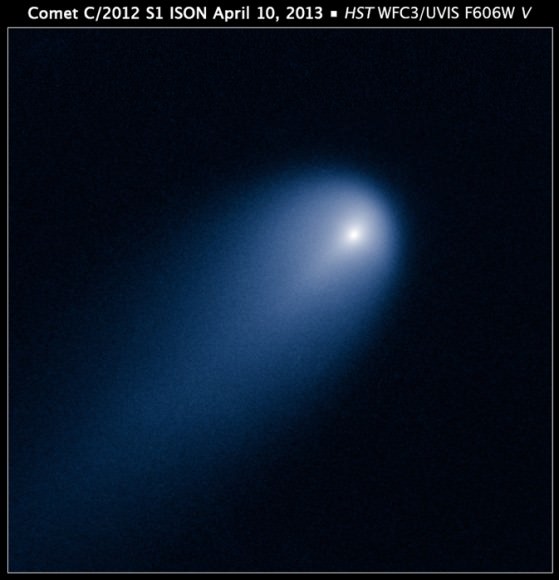
NASA’s Swift satellite and the Hubble Space Telescope (HST) have also imaged Comet ISON recently in this region of space. Swift’s ultraviolet observations determined that the comet’s main body was spewing some 850 tons of dust per second at the beginning of the year, leading astronomers to estimate the comet’s nucleus diameter is some 3-4 miles (5-6 kilometers). HST scientists concurred with that size estimate, adding that the comet’s coma measures about 3100 miles (5000 km) across.
The comet gets brighter as the outgassing increases and pushes more dust from the surface of the comet. Scientists are using the comet’s brightness, along with information about the size of the nucleus and measurements of the production of gas and dust, to understand the composition of the ices that control the activity. Most comets brighten significantly and develop a noticeable tail at about the distance of the asteroid belt (about 3 times the Earth-Sun distance –– between the orbits of Mars and Jupiter) because this is when the warming rays of the Sun can convert the water ice inside the comet into a gas. This comet was bright and active outside the orbit of Jupiter — when it was twice as far from the Sun. This meant that some gas other than water was controlling the activity.
Meech said that Comet ISON “…could still become spectacularly bright as it gets very close to the Sun” but also added caution. “I’d be remiss, if I didn’t add that it’s still too early to predict what’s going to happen with ISON since comets are notoriously unpredictable,” she said.
Source: Gemini Observatory
The Orion Nebula as You’ve Never Seen it Before: Jaw-dropping New Image from Gemini
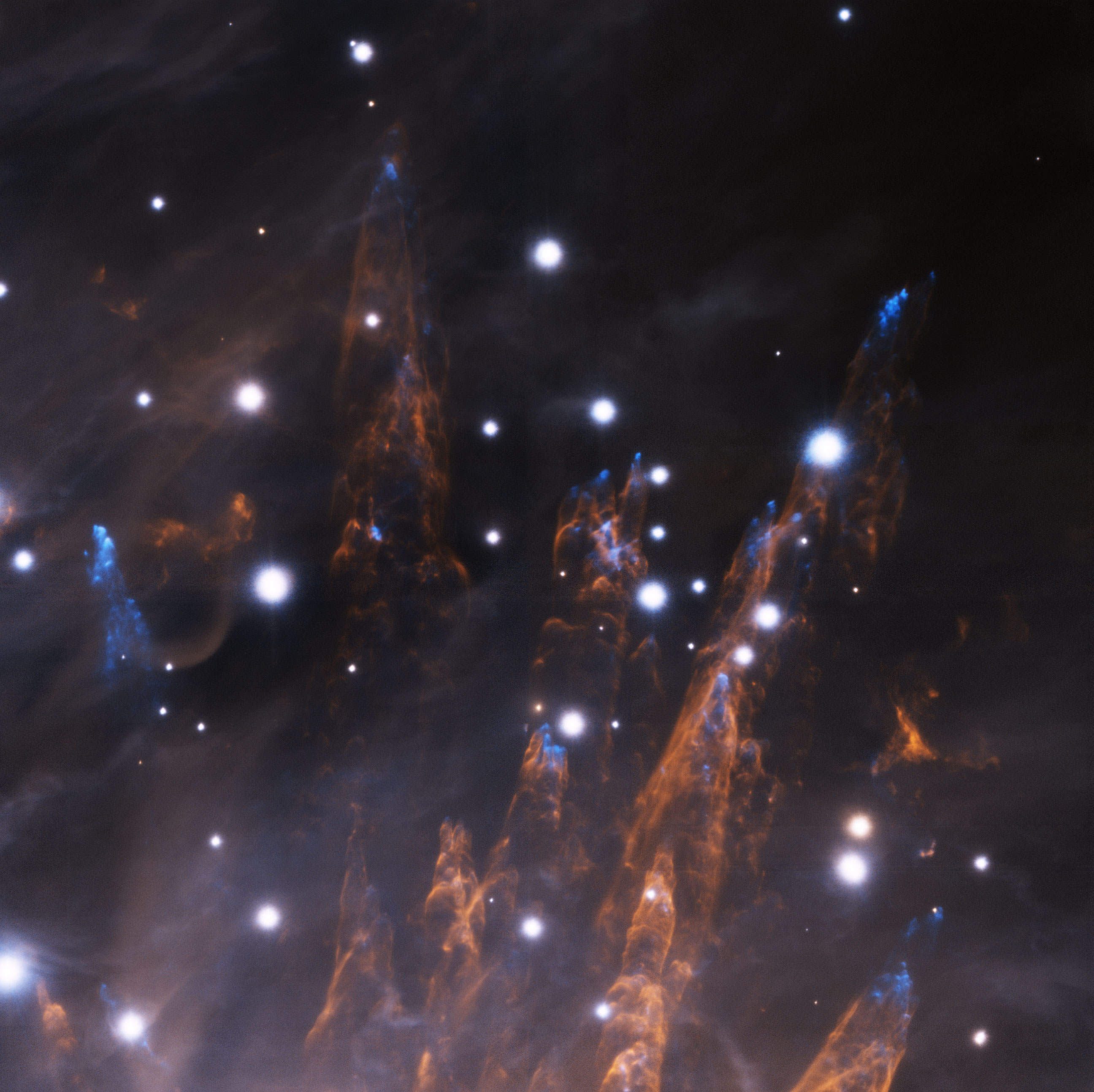
This is the part of the Orion nebula. Recognize it? You may not, as this stunning new image comes from the Gemini Observatory’s recently-commissioned advanced adaptive optics (AO) system named GeMS. It shows clumps of gas ejected from deep within the Orion Nebula which are nicknamed ‘Orion Bullets.’
“The combination of a constellation of five laser guide stars with multiple deformable mirrors allows us to expand significantly on what has previously been possible using adaptive optics in astronomy,” said Benoit Neichel, who currently leads this adaptive optics program for Gemini. “For years our team has focused on developing this system, and to see this magnificent image, just hinting at its scientific potential, made our nights on the mountain – while most folks were celebrating the New Year’s holiday – the best celebration ever!”
The team took the image on December 28, 2012.
About five years ago, astronomers took an image of the Orion Bullets using a previous version of adaptive optics called Altair. Gemini’s instrument scientist for Altair, Chad Trujillo, pointed out that in one shot GeMS covers a significantly larger field-of-view than Altair and a higher quality image.
“The uniformity and performance across the image is amazing! In this new image, the pixels are 2.5 times finer and there are about 16 times more of them,” he said. Both the correction quality and the field-of-view are considerably better than the previous generation of AO systems.”
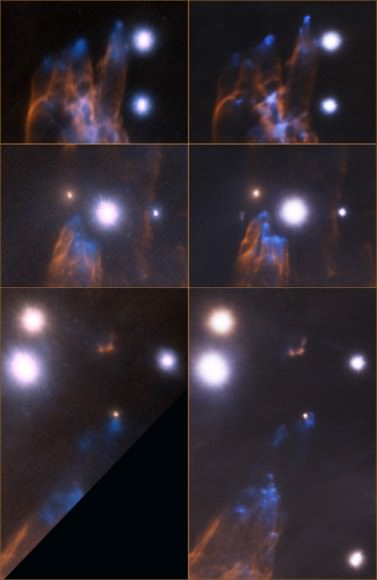
Read more about the GeMS system at the Gemini Observatory website.
Galactic Struggle Captured by Gemini Observatory
The Gemini Multi-Object Spectroraph on the Fredrick C. Gillett Gemini North Telescope on Mauna Kea in Hawaii captured this beautiful image of the ring galaxy NGC 660. The galaxy lies about 40 million light-years from Earth toward the constellation Pisces the Fishes. The field of view of the zoomed out image is 9.3×5.6 arcminutes. North is to the right and east is up. Total exposure for the image for all filters was 1,620 seconds. Credit: Gemini Observatory/AURA.
Strings of gas and dust, the wreckage of a colossal galactic struggle, lie strewn and littered about polar-ring galaxy NGC 660 in this new image from the Gemini Observatory.
Zoom around the ring of stars, stop to dive into massive star clusters and pink nebulae rich with the birth of new stars. Astronomers have found only a few of these bizarre objects. Most are made up of an early-type spiral galaxy, known as a lenticular galaxy, surrounded by a vast ring of stars extending for tens of thousands of light-years nearly perpendicular to the plane of the main galaxy. NGC 660, however, is the only polar-ring galaxy with a late-type lenticular galaxy as host.
Continue reading “Galactic Struggle Captured by Gemini Observatory”
Absorption Lines Shed New Light on 90 Year Old Puzzle
[/caption]
Using the Gemini North Telescope, astronomers studying the central region of the Milky Way have discovered 13 diffuse interstellar bands with the longest wavelengths to date. The team’s discovery could someday solve a 90-year-old mystery about the existence of these bands.
“These diffuse interstellar bands—or DIBs—have never been seen before,” says Donald Figer, director of the Center for Detectors at Rochester Institute of Technology and one of the authors of a study appearing in the journal Nature.
What phenomenon are responsible for these absorption lines, and what impact do they have on our studies of our galaxy?
Figer offers his explanation of absorption lines, stating, “Spectra of stars have absorption lines because gas and dust along the line of sight to the stars absorb some of the light.”
Figer adds, “The most recent ideas are that diffuse interstellar bands are relatively simple carbon bearing molecules, similar to amino acids. Maybe these are amino acid chains in space, which supports the theory that the seeds of life originated in space and rained down on planets.”
“Observations in different Galactic sight lines indicate that the material responsible for these DIBs ‘survives’ under different physical conditions of temperature and density,” adds team member Paco Najarro (Center of Astrobiology, Madrid).
The discovery of low energy absorption lines by Figer and his team helps to determine the nature of diffuse interstellar bands. Figer believes that any future models that predict which wavelengths the particles absorb will have to include the newly discovered lower energies, stating, “We saw the same absorption lines in the spectra of every star. If we look at the exact wavelength of the features, we can figure out the kind of gas and dust between us and the stars that is absorbing the light.”
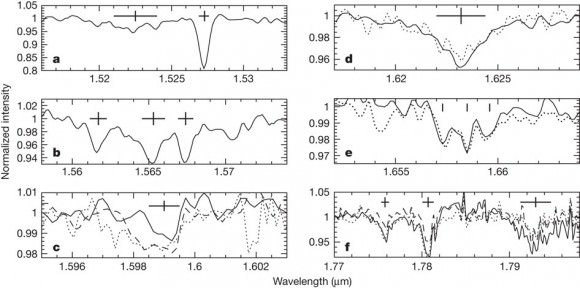
Image Credit: Geballe, Najarro, Figer, Schlegelmilch, and de la Fuente.
Since their discovery 90 years ago, diffuse interstellar bands have been a mystery. To date, the known bands that have been identified before the team’s study occur mostly in visible wavelengths. Part of the puzzle is that the observed lines don’t match the predicted lines of simple molecules and can’t be traced to a single source.
“None of the diffuse interstellar bands has been convincingly identified with a specific element or molecule, and indeed their identification, individually and collectively, is one of the greatest challenges in astronomical spectroscopy, recent studies have suggested that DIB carriers are large carbon-containing molecules.” states lead author Thomas Geballe (Gemini Observatory).
One other benefit the newly discovered infrared bands offer is that they can be used to better understand the diffuse interstellar medium, where thick dust and gas normally block observations in visible light. By studying the stronger emissions, scientists may gain a better understanding of their molecular origin. So far, no research teams have been able to re-create the interstellar bands in a laboratory setting, mostly due to the difficulty of reproducing temperatures and pressure conditions the gas would experience in space.
If you’d like to learn more about the Gemini Observatory, visit: http://www.gemini.edu/
Read more about RIT’s Center for Detectors at: http://ridl.cis.rit.edu/
Observing Alert: Bright Spot On Uranus Reported
[/caption]
There’s nothing like a dynamic solar system… and right now another planet is being heard from. According to various sources, a bright spot – possibly a developing storm – has been spotted on Uranus.
“Professional observers this morning (October 27) reported a very bright cloud on Uranus, using the Gemini telescope, and need amateur confirmation if possible, to obtain a rotation period.” says John H. Rogers, Jupiter Section Director, British Astronomical Association. “Near-infrared filters may have the best chance of detecting it. It was recorded in the 1.6 micron band, which is further into the IR than amateurs can reach, but your usual near-IR filters might be successful. I think that methane filters are not especially promising, as these clouds on Uranus are overlaid by a methane-rich layer of atmosphere, but would be worth trying anyway. Anyone who has a 1-micron filter should have a go too.”
At this point in time, information is limited, but professional images taken using the 8.1-metre Gemini Telescope North on Hawaii have recorded a region said to be ten times brighter than the planetary background. The bright spot is believed to be attributed to methane ice. ““This is an H-band image, centered at 1.6 microns, close to the wavelength of maximum contrast for such features. Its contrast will decrease with decreasing wavelength, and will likely not be detectable by amateur astronomers, except possibly at the longer CCD wavelengths where the Rayleigh scattering background can be suppressed.” says Larry Sromovsky, of the University of Wisconsin-Madison. “Looking with a methane band filters at 890 nm might be productive, especially if the feature continues to brighten.”
“The feature is not very large; instead its prominence is due to its high altitude, placing it above the intense absorption of methane in the deeper atmosphere. This is much higher than the 1.2-bar methane condensation level and thus it is expected to be predominantly composed of methane ice particles.”
Dr Sromovsky added: “The latitude of the feature is approximately 22.5° north planetocentric, which is a latitude nearly at rest with respect to the interior. So it should rotate around Uranus’ axis with nearly a 17.24-hour period. At the time of the image, the feature’s longitude was 351° West. That could change slowly in either direction.
“The low latitude is unusual. Previous exceptionally bright cloud features on Uranus were at close to 30° North, both in 1998 (Sromovsky et al. 2000, Icarus 146, 307-311) and in 2005 (Sromovsky et al. 2007, Icarus 192, 558-575). The 2005 feature oscillated ±1° about its mean latitude. The new feature might also oscillate in latitude, in which case its longitudinal drift rate might also vary with time.”
Hang in there, UT readers! Right now we have two of our best astrophotographers doing their best to give us an exclusive look! This page will be updated as more information becomes available.
Partial Quote Source: Skymania News Release.
Spectacular Galaxies Dancing Towards Destruction

[/caption]
More than just another pretty picture? I’ll say! This beautiful image of the galaxy pair NGC 6872 and IC 4970 was part of a competition for high school students in Australia to obtain scientifically useful (and aesthetically pleasing) images using the Gemini Observatory. The winners were students from the Sydney Girls High School Astronomy Club in central Sydney, who proposed that Gemini investigate these two galaxies that are embraced in a graceful galactic dance that, — as the team described in the essay to support their entry — “…will also serve to illustrate the situation faced by the Milky Way and the Andromeda galaxy in millions of years.”
We can only hope we look this pretty millions of years from now!
This image shows what happens when galaxies interact, and how the gravitational forces distort and tear away at their original structure. Spiral galaxies can have their arms elongate out to enormous distances: in NGC 6872, the arms have been stretched out to span hundreds of thousands of light-years—many times further than the spiral arms of our own Milky Way galaxy. Over hundreds of millions of years, NGC 6872’s arms will fall back toward the central part of the galaxy, and the companion galaxy (IC 4970) will eventually be merged into NGC 6872.
But that will be another pretty picture, as galaxy mergers often leads to a burst of new star formation. Already, the blue light of recently created star clusters dot the outer reaches of NGC 6872’s elongated arms. Dark fingers of dust and gas along the arms soak up the visible light. That dust and gas is the raw material out of which future generations of stars could be born.

Learn more about the contest and the winning team at this article on the Gemini website. Also, a new contest is underway for Australian students in 2011, and more details can be found at this link.
Source: Gemini Observatory
Mystery Object Found Orbiting Brown Dwarf
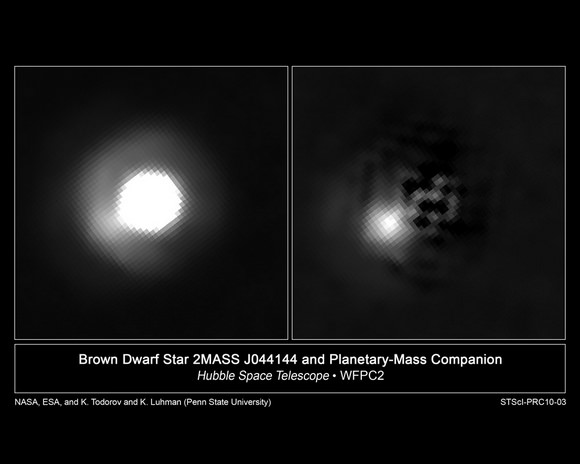
[/caption]
Big planet or companion brown dwarf? Using the Hubble Space Telescope and the Gemini Observatory, astronomers have discovered an unusual object orbiting a brown dwarf, and its discovery could fuel additional debate about what exactly constitutes a planet. The object circles a nearby brown dwarf in the Taurus star-forming region with an orbit approximately 3.6 billion kilometers (2.25 billion miles) out, about the same as Saturn from our sun. The astronomers say it is the right size for a planet, but they believe the object formed in less than 1 million years — the approximate age of the brown dwarf — and much faster than the predicted time it takes to build planets according to conventional theories.
Kamen Todorov of Penn State University and his team conducted a survey of 32 young brown dwarfs in the Taurus region.
The object orbits the brown dwarf 2M J044144 and is about 5-10 times the mass of Jupiter. Brown dwarfs are objects that typically are tens of times the mass of Jupiter and are too small to sustain nuclear fusion to shine as stars do.
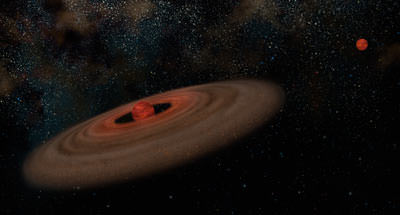
While there has been a lot of discussion in the context of the Pluto debate over how small an object can be and still be called a planet, this new observation addresses the question at the other end of the size spectrum: How small can an object be and still be a brown dwarf rather than a planet? This new companion is within the range of masses observed for planets around stars, but again, the astronomers aren’t sure if it is a planet or a companion brown dwarf star.
The answer is strongly connected to the mechanism by which the companion most likely formed.
The Hubble new release offers these three possible scenarios for how the object may have formed:
Dust in a circumstellar disk slowly agglomerates to form a rocky planet 10 times larger than Earth, which then accumulates a large gaseous envelope; a lump of gas in the disk quickly collapses to form an object the size of a gas giant planet; or, rather than forming in a disk, a companion forms directly from the collapse of the vast cloud of gas and dust in the same manner as a star (or brown dwarf).
If the last scenario is correct, then this discovery demonstrates that planetary-mass bodies can be made through the same mechanism that builds stars. This is the likely solution because the companion is too young to have formed by the first scenario, which is very slow. The second mechanism occurs rapidly, but the disk around the central brown dwarf probably did not contain enough material to make an object with a mass of 5-10 Jupiter masses.
“The most interesting implication of this result is that it shows that the process that makes binary stars extends all the way down to planetary masses. So it appears that nature is able to make planetary-mass companions through two very different mechanisms,” said team member Kevin Luhman of the Center for Exoplanets and Habitable Worlds at Penn State University.
If the mystery companion formed through cloud collapse and fragmentation, as stellar binary systems do, then it is not a planet by definition because planets build up inside disks.
The mass of the companion is estimated by comparing its brightness to the luminosities predicted by theoretical evolutionary models for objects at various masses for an age of 1 million years.
Further supporting evidence comes from the presence of a very nearby binary system that contains a small red star and a brown dwarf. Luhman thinks that all four objects may have formed in the same cloud collapse, making this in actuality a quadruple system.
“The configuration closely resembles quadruple star systems, suggesting that all of its components formed like stars,” he said.
The team’s research is being published in an upcoming issue of The Astrophysical Journal.
The team’s paper: Discovery of a Planetary-Mass Companion to a Brown Dwarf in Taurus
Source: HubbleSite

